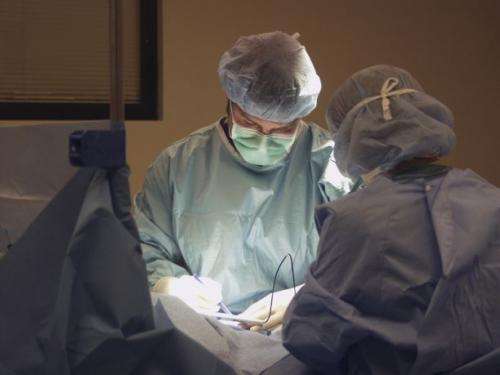Surgeon, optical scientist collaborate on surgery camera

(Medical Xpress)—Dr. Mike Nguyen, a urologist and UA associate professor of surgery, and Hong Hua, a UA professor of optical sciences, have teamed up with the goal of creating a camera that will allow surgeons to view both wide angle and high-resolution, close-up images simultaneously using a single, integrated probe.
During laparoscopic surgery, which is performed through a small incision in the body, usually in the abdomen, surgeons typically obtain either wide angle or close-up images by manually moving a probe with a video camera in and out of the incision – closer to or further from the area in which they are operating. This is done with help from a trained assistant holding the probe.
The existing system presents a few challenges, Nguyen said. For one, it can be complicated to move the camera in and out through the same incision, or "portal," through which other surgical instruments also are being inserted and maneuvered.
"When you put the camera and instruments into the same space, you start running into each other and you get conflicts. That's one issue, an ergonomic issue," Nguyen said.
Another concern is that because the existing cameras can't capture zoomed-in and broad view images at the same time, a surgeon might not see problems outside the camera's immediate focus area.
"Because laparoscopic surgery is usually done 'zoomed in,' you kind of lose peripheral vision when you're operating," Nguyen said. "Anything that's happening outside your view, you're not aware of. For example, if you're operating on the kidney over here and there's an injury that's occurred on one of the main vessels over here, we may not be aware of it."
To address those issues, Nguyen and Hua are working to create a stationary camera that could simultaneously zoom in to capture detailed close-up views, automatically tracking where the surgeon is working, and also obtain wide-angle overviews. They say the camera has the potential to aid in surgical ease and patient safety.
"The combination of being able to zoom optically and being able to capture a wide-angle view has some significant advantages," Nguyen said. "One is the camera doesn't even have to move. It just sits in one place while it zooms and tracks. It can just be mounted, and you don't need an assistant to hold it anymore, and because it's not moving, it conflicts less with other surgical instruments."
When multiple tools can more easily be maneuvered through one opening, it reduces the need for additional incisions and thus cuts down on scarring and healing time, Nguyen said.
Furthermore, the camera's ability to capture two views at once has the potential to make laparoscopic surgery safer, Nguyen said.
"The idea of this camera is it allows for focusing on one area, but because it's capturing the wide view as well, the surgeon can stay focused on the details, but not lose sight of the big picture," he said.
The camera, designed to zoom optically, allows for close-up images with nine times higher resolution than those captured by a standard scope, Hua said. Optical zoom capability provides higher resolution than digital zoon, which can distort image quality.
The researchers still are trying to determine how best to display the dual images captured by the camera – for example, side by side, as an overlay or with a "picture in picture" format. Further study is needed to determine which would be most effective for the surgeon, Hua said.
Nguyen and Hua are working to develop the camera, which has not yet undergone biological testing, with a grant from the National Institutes of Health.
Nguyen said he hopes they can help advance the field of minimally invasive surgery with the new technology.
"This can potentially make minimally invasive surgery safer and allow us to use instruments more efficiently," Nguyen said. "This technology allows it to potentially overcome some of the issues we face in laparoscopic surgery to make adoption of these types of surgeries easier and safer."
















